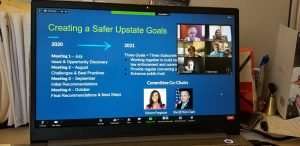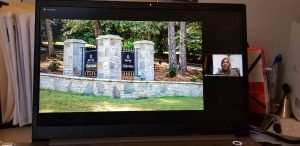
Nov 5, 2021 | Creating a Safer Upstate, Safer Upstate
 Creating a Safer Upstate
Creating a Safer Upstate
November 2, 2021
Watch a video of the presentation here.
Speakers
Chief Matt Hamby, City of Greer
Chief TJ Chaudoin, City of Greenwood (c:864-992-7304)
Chief Howie Thompson, City of Greenville
Community Leaders
Dr. Toney Parks, Senior Pastor at Mt. Sinai Baptist, and Chaplain to Greenville City Police
Mayor Terence Roberts, Mayor of Anderson, and Board of Directors Chair of TATT
Keishe Nelson, Credit Manager at Michelin Community Volunteer
Challenges to Hiring, Recruiting, Training
Chief Chaudoin
Recruiting
- Relying more on communities
- Focus on minorities
- It’s a competitive market
- Develop open dialogue with council persons in each zone
- Reduce turnover
- The hiring process takes six months, including:
- First application
- Panel interview
- Psychological evaluation
- Nelson Denney Test
- Polygraph
- Physical
- Conditional offer
- Academy
- PTO training program for 7-8 months
How have they been recruiting
- Minority campaigns partnered with Army, Army PAYS program, first black female applicant currently in process, veterans to top of pool
- Hiring workshops at convention center, with physical agility test
- Hosted African American men ___org) at range
- Yard signs in neighborhoods
- Find Value Be Valued campaign, hired eight with previous experience
Chief Thompson
Some of the minimum standards set by state law (an average of 6% of applications received are eligible):
- At least 21 years old
- Citizen
- High School Diploma or equivalent
- SC driver’s license
- No driver’s license suspensions
- No felonies, crimes of moral turpitude
- Good credit history
Chief Hamby
Studies show that 29% of officers leave within first year of being hired nationally. An additional 40% leave the professional within 5 years. 8-20% stay to reach retirement. According to the SC Academy, in five years, 50% of the class is no longer in law enforcement after graduation.
Creativity is required in retention. Opportunities in Greer are available to:
- Work toward being detective
- Become a school resource officer
- Work toward the K-9 Team or drone team
- Participate in cross-training,
- Receive private vendor training
- Play a role in future planning and be part of a team
Recruiting
- Greer offers a cash incentive to current officers to recruit – $500 for new hire plus $500 at end of probation period
- College kids from Citizen’s Academy, from Greenville Tech, North Greenville University, Bob Jones, Anderson, and Furman
- Develop relationships early, tour, take to lunch, ride alongs
Community Leader Q&A
Pastor Parks
What is the plan to encourage Latinx population?
Chief Chaudoin
Become actively involved in the community to build relationships for the future
Chief Thompson
Largest growing population in Greenville
Partnered with Hispanic Alliance job fairs
Aside-15% of the department is female
Chief Hamby
Focusing on all minorities and getting them to apply
Mayor Roberts
How can elected officials help with recruiting and retention?
Chief Chaudoin
Bring elected officials along into communities
Focusing on recruiting next generation of hires
Chief Hamby
Provide leads of interested parties
Chief Thompson
Invite us to speak even to events you might not think are related
Keishe Nelson
What training has been implemented to counter tragedies?
Chief Chaudoin
Outside agency oversight through national accreditation
Increase training budget
Specialize in communication and de-escalation
Chief Thompson
Review policies to ensure up to date
Repetitive training on simulators
Biased based training
Chief Hamby
Emotional intelligence training – entire staff
Crisis interventional training by NAMI
What has been learned from open dialogue in communities?
Chief Chaudoin
Everyone learns about each other; community understands force, office understands community concerns
Chief Thompson
New NET Team (neighborhood engagement team)
Goal – promote safety, prevent crime, enhance quality of life, neighborhood led
Chief Hamby
Every department relies of community support
With removing someone’s freedom comes heavy responsibility, so a high level of trust must be obtained by getting to know each other outside “business” dealings
Builds trust and understanding

Oct 4, 2021 | Safer Upstate
Thank you for registering for Ten at the Top’s Technology in Law Enforcement workshop yesterday. Please share this recording of the workshop with any Upstate organizations or members of your community that might be interested in hearing about how technology like license plate readers, body cameras, and drones are being used to solve crimes in our communities.
The law enforcement panel included Chief Jorge Campos from the Clemson Police Department, Captain Fred Forman from the Simpsonville Police Department, and Chief Matt Hamby from the Greer Police Department.
Chief Hamby introduced body-worn cameras (BWCs) and the evolution of BWC technology. Chief Campos discussed accountability, standards, and guidelines, the use of BWCs to in court cases, automation to increase usability and accuracy, privacy issues, and limitations of the technology. Captain Forman discussed the Simpsonville department’s use of license plate readers (LPRs) to solve crimes quickly in an objective and unbiased manner while saving taxpayer dollars.
Community leaders who participated in this session were Yvonne Reeder and Corey McDowell.
This workshop was highly informative about what technology law enforcement is using, how it works, how it is being used and how it is not being used, and methods utilized to maintain the safety and privacy of Upstate citizens. If you were not able to attend the workshop, please take some time to watch the recording and share it widely.
As part of the Creating a Safer Upstate initiative, Ten at the Top will continue to host this series of “Beyond the Shield” Virtual Workshops featuring conversations between law enforcement officers and community leaders around key law enforcement topics. Watch for a date for the next workshop featuring information on law enforcement recruitment, retention, and training.

Jul 30, 2021 | Safer Upstate, Staying on Top
 Special Program Update: Creating a Safer Upstate – Sheriff Rick Clark & Stinson Ferguson
Special Program Update: Creating a Safer Upstate – Sheriff Rick Clark & Stinson Ferguson
You can view a recording of the meeting here and the presentation here.
Last year a steering committee was created with representatives across the Upstate from law enforcement, non-profits, clergy, citizens, and business leaders. Questions to address included what does a safer Upstate look Like? Who has the power to create a safer Upstate? How do we move forward? How do we engage non-English speakers? How do we capture the voices of young people? What information do we need? What are the barriers to success?
Three goals were recommended with one subcommittee to work on each:
Goal #1: Engage law enforcement officials, community leaders and residents to work together to build healthy working relationships that elevate mutual respect, value cultural differences, and acknowledge the roles and responsibilities that each play in creating safer Upstate Communities.
Goal #2: Provide regular opportunities for law enforcement and community leaders to convene to discuss community issues and emerging law enforcement topics while exploring approaches that can be implemented across the Upstate Region.
Goal #3: Enhance public trust by documenting, sharing and implementing best practice approaches for developing a sustainable, healthy relationship between law enforcement officials and the greater Upstate Community.
Police Department Community Outreach Survey – Chief Matt Hamby
As part of Goal #1, this subcommittee created a Police Community Engagement Survey. Please see the presentation for survey results:
- The Safer Upstate Task Force created a survey asking about police community engagement that was sent out to 57 police departments and sheriff’s offices in Upstate South Carolina.
- We received responses from 28 police departments and 4 sheriff’s offices.
- We received a response from at least one department in all 10 counties in the Upstate.
Chief Hamby shared community engagement opportunities in Greer including summer youth camps, Fist Bump Fridays at schools, Citizens Academies, and National Nights Out. Chief Hamby encouraged agencies to request funding for community engagement. With the Greer budget of $4,000, they can engage many members of their community and build healthy relationships.
Tri-County Outreach Efforts and Community Meetings – Jacquelyn Blakley
Tri-County Tech, in conjunction with Clemson University and the Creating a Safer Upstate committee, has developed Community Leader Forums:
- Partners: Tri-County, Clemson University and Creating a Safer Upstate
- Attendees: Community leaders and law enforcement in Anderson, Oconee and Pickens Counties
- Goal: Build trust and develop healthy, sustainable relationships
Forums will include:
- Roundtable Discussion
- Police training and credentials
- Community engagement
- Neighborhood safety concerns
- Policing policies
- Other topics
Announcement of Community Safety Virtual Workshop Series – Kim Kegler
Beyond the Shield:
Perceptions, Realities & Community Concerns Around “Hot Button” Public Safety Issues
Each one-hour virtual session will include law enforcement officers and community leaders discussing elements of policing and how to build a collaborative understanding and dialogue around the issues, concerns and opportunities to create a Safer Upstate.
Creating a Safer Upstate Committee Initiatives – Stan Davis
Group #1 will move forward with a focus on data with a template to share information and include community engagement opportunities. Group #2 is pulling together programs to create awareness. Group #3 has taken the before-school engagement activities and piloted the concept around the Upstate with 11 schools visited at the end of the school year and a positive news story by Fox 21 as a result. The efforts of the committees will expand the role that residents play and continue to share best practices.
Resource Update – Billy Crank, LEAD Upstate
- Law Enforcement Appreciation Day (LEAD) started with Seabrook Marchant buying breakfast for officers at Tommy’s Ham House and grew to an annual sit-down breakfast the Westin Poinsett Hotel.
- Due to COVID, a drive through line was set up last year, providing 450 breakfasts and goody bags in 2020
- The goal of LEAD Upstate is to bridge the local community and law enforcement together in the name of appreciation and gratitude.
- LEAD Upstate provides an opportunity for residents to say thank you to all law enforcement personnel in Greenville County, including Greenville, Greer, Traveler’s Rest, Mauldin, Simpsonville and Fountain Inn.
- Our sponsors are honored to host this event and participate by serving breakfast and handing out prizes.

Dec 18, 2020 | Community Vibrancy, Driver Areas, Safer Upstate, Staying on Top
 Welcome – Terence Roberts, TATT Chairman
Welcome – Terence Roberts, TATT Chairman
Year in Review
TATT 2020 Overview – Dean Hybl, TATT Executive Director
Upstate Mobility Alliance – Michael Hildebrand, UMA Director
Upstate Entrepreneur Ecosystem – Erin Ouzts, Ecosystem Coordinator
TATT Initiatives – Justine Allen, TATT Program Manager
County Updates
Abbeville – Stephen Taylor, Economic Development Director
Decrease in ROIs and unemployment hit 13.9% in May but decrease to 4.2% in October
Marketing focus in 2021 with assistance from Department of Commerce
Promise Campaign and workforce to be highlighted
Water study and public transportation study also in 2021
Oconee – Christine de Vlaming, Marketing Director, Keowee Key
Real estate is sold out at close to 4,000 residents
 Keowee Key’s model of engaging volunteer professionals includes a videographer with drone capabilities, photographer, landscape designer, and project manager (see presentation during video recording for examples of their work)
Keowee Key’s model of engaging volunteer professionals includes a videographer with drone capabilities, photographer, landscape designer, and project manager (see presentation during video recording for examples of their work)
Union – Annie Smith, Marketing & Development Director, USC Union
USC Union received a 88.2% success rating
Started a Bachelor of Science/Nursing degree with 16 upper division juniors and 16 upper division seniors on campus this fall
Granted 100K dollars for upgrades to facilities, including projecting microscopes
10K grant to stock a student food pantry (large need)
Athletic department competes in the national junior college league, NJCAA, and has added a women’s volleyball team
Acquired an old high school gym in Jonesville to be renovated into an indoor training facility which is huge for recruitment (only one in the league)
Union County has designated many new development regions to attract new families and business

Oct 30, 2020 | Safer Upstate, Staying on Top, Uncategorized
 Following a series of four meetings convened through Ten at the Top (TATT), the Creating a Safer Upstate Discovery Committee has announced a series of recommendations designed to promote collaboration among stakeholders in fostering a culture in the Upstate that respects and values the lives of all officers and residents. To view the list of recommendations, click here.
Following a series of four meetings convened through Ten at the Top (TATT), the Creating a Safer Upstate Discovery Committee has announced a series of recommendations designed to promote collaboration among stakeholders in fostering a culture in the Upstate that respects and values the lives of all officers and residents. To view the list of recommendations, click here.
The Discovery Committee was originally convened by Terence Roberts, Chairman of the Ten at the Top Board of Directors and the Mayor of the City of Anderson, following a number of highly publicized instances of police force across the country.
“While our region has been fortunate not to have seen the violence and social unrest that has occurred in other parts of the country, we do recognize that not every Upstate resident feels safe or trusts our law enforcement officers, Roberts said. “We felt with the platform already established by Ten at the Top to be a neutral convener, that we had an opportunity to proactively engage stakeholders across the region around the topic of creating a safer region for all residents.”
The Creating a Safer Upstate Discovery Committee consisted of more than 50 representatives from local governments, law enforcement, community organizations, faith leaders and Upstate businesses. The committee met virtually four times to discuss opportunities for how to create a united Upstate region where all stakeholders work collaboratively to ensure that we foster a culture that respects and values the lives of our law enforcement officers and all residents.
As the primary strategy, the Discover Committee recommends the development of a Safer Upstate Steering Committee to represent, support and communicate local efforts to improve relationships between law enforcement and community residents across the region. The Safer Upstate Steering Committee will focus on the following three goals:
1. Engage law enforcement officials, community leaders and residents to work together to build healthy working relationships that elevate mutual respect, value cultural differences, and acknowledge the roles and responsibilities that each play in creating safer Upstate Communities.
2. Provide regular opportunities for law enforcement and community leaders to convene to proactively discuss community issues and emerging law enforcement topics while exploring approaches that can be implemented across the Upstate Region.
3. Enhance public trust by identifying, sharing and implementing best practice approaches for developing a sustainable, healthy relationship between law enforcement officials and the greater Upstate Community.
The Steering Committee will be under the leadership of co-chairs Sheriff Rick Clark and Stinson Ferguson. Both Upstate natives, Sheriff Clark has been the sheriff of Pickens county since 2013 while Ferguson is Special Counsel for Haynsworth Sinkler Boyd, P.A. in Greenville.
More information about the Safer Upstate initiative can be found at www.tenatthetop.org. Anyone interested in becoming a member of the Safer Upstate Steering Committee is invited to reach out to Justine Allen, TATT Program Manager, at jallen@tenatthetop.org or 864-283-0346.
ABOUT TEN AT THE TOP
Comprised of public, private and civic leaders from across the ten-county Upstate South Carolina Region, Ten at the Top was created to connect and encourage regional collaboration through data-driven research and regular convening of leaders and citizens to address key issues facing the region. Ten at the Top works with regional partners to foster collaboration and strategic planning to enhance the economic vitality and quality of life for Upstate residents both today and as the region continues to grow. For more information, visit www.tenatthetop.org.
To view the list of recommendations, click here.
Creating a Safer Upstate Discovery Committee Members
|
First Name
|
Last Name
|
Organization
|
Position
|
|
Katherine
|
Amidon
|
Synterra
|
Market Leader, Environmental Planning
|
|
Bill
|
Barnet
|
Barnet Development Group
|
CEO
|
|
Steve
|
Brown
|
Greenwood County
|
Chairman
|
|
Carol
|
Burdette
|
United Way of Anderson County
|
President
|
|
Paul
|
Cain
|
Oconee County
|
Councilman
|
|
Becky
|
Callaham
|
Safe Harbor
|
Executive Director
|
|
Rick
|
Clark
|
Pickens County
|
Sheriff
|
|
Roy
|
Costner
|
Pickens County
|
Chairman
|
|
Michael
|
Cunningham
|
AnMed Health
|
Vice President for Advancement
|
|
Rick
|
Danner
|
City of Greer
|
Mayor
|
|
Chandra
|
Dillard
|
SC House
|
Representative
|
|
Sean
|
Dogan
|
Urban League of the Upstate
|
Interim CEO
|
|
Stephanie
|
Enders
|
Ripple of One
|
Executive Director
|
|
David
|
Feild
|
Colliers International
|
Market President
|
|
Stinson
|
Ferguson
|
Haynsworth Sinkler Boyd
|
Special Counsel
|
|
Santana
|
Freeman
|
City of Abbeville
|
Mayor
|
|
Freddie
|
Gault
|
Office of Congressman William Timmons
|
Outreach Director
|
|
LaTorrie
|
Geer
|
Community Works
|
Chief Operating Officer
|
|
Danielle
|
Gibbs
|
Senator Scott Office
|
Upstate Director
|
|
Charlie
|
Hall
|
Upstate Warrior Solution
|
Executive Director
|
|
Matt
|
Hamby
|
City of Greer
|
Police Chief
|
|
Michael
|
Hildebrand
|
Upstate Mobility Alliance
|
Director of Inclusion & Diversity
|
|
Dan
|
Holland
|
Oconee County
|
Cultural Diversity Director
|
|
Todd
|
Horne
|
Clayton Construction
|
Vice President
|
|
Missy
|
House
|
City of Inman
|
City Administrator
|
|
Tammie
|
Hoy Hawkins
|
Community Works
|
CEO
|
|
Dean
|
Hybl
|
Ten at the Top
|
Executive Director
|
|
Scott
|
Junkins
|
Harris Flooring America
|
Owner
|
|
Kimbrelly
|
Kegler
|
Michelin
|
Future Product Portfolio Leader
|
|
Dennis
|
Kelly
|
Greenwood County
|
Sheriff
|
|
Mitch
|
Kennedy
|
City of Spartanburg
|
Assistant City Manager
|
|
Butch
|
Kirven
|
Greenville County
|
Chairman
|
|
Sonny
|
Ledda
|
City of Clinton
|
Police Chief
|
|
Jil
|
Littlejohn
|
Hubbell Incorporated
|
Director of Inclusion & Diversity
|
|
Erwin
|
Maddrey
|
Maddrey & Associates
|
CEO
|
|
David
|
McCuen
|
City of Anderson
|
City Manager
|
|
Keith
|
McDaniel
|
Macedonia Missionary Baptist Church
|
Pastor
|
|
Adela
|
Mendoza
|
Hispanic Alliance
|
Executive Director
|
|
Stacey
|
Mills
|
USC-Upstate
|
University Center Executive Director
|
|
Amanda
|
Munyan
|
Laurens County Chamber
|
President
|
|
Floyd
|
Nicholson
|
SC Senate
|
Senator
|
|
Carlos
|
Phillips
|
Greenville Chamber
|
CEO
|
|
Andrena
|
Powell-Baker
|
Lockhart Power
|
Senior Manager
|
|
Tricia
|
Ravenhorst
|
SC Coalition Against Domestic Violence
|
General Counsel
|
|
Terence
|
Roberts
|
City of Anderson
|
Mayor
|
|
Jim
|
Shew
|
Marsh & McLennan
|
Vice President
|
|
George
|
Shira
|
Milliken
|
Vice President of Human Resources
|
|
Paige
|
Stephenson
|
United Way of the Piedmont
|
President
|
|
Jim
|
Stewart
|
City of Anderson
|
Police Chief
|
|
Harold
|
Thompson
|
City of Union
|
Mayor
|
|
Alonzo
|
Thompson
|
City of Spartanburg
|
Police Chief
|
|
Theresa
|
Thompson
|
Upstate Warrior Solution
|
Deputy Director
|
|
Wendy
|
Walden
|
Greenville Tech
|
Associate Vice President
|
|
Greg
|
Whitaker
|
Clemson University
|
Deputy Campus Police Chief
|

 Creating a Safer Upstate
Creating a Safer Upstate 

 Special Program Update: Creating a Safer Upstate – Sheriff Rick Clark & Stinson Ferguson
Special Program Update: Creating a Safer Upstate – Sheriff Rick Clark & Stinson Ferguson
 Welcome – Terence Roberts, TATT Chairman
Welcome – Terence Roberts, TATT Chairman Keowee Key’s model of engaging volunteer professionals includes a videographer with drone capabilities, photographer, landscape designer, and project manager (see presentation during video recording for examples of their work)
Keowee Key’s model of engaging volunteer professionals includes a videographer with drone capabilities, photographer, landscape designer, and project manager (see presentation during video recording for examples of their work)
 Following a series of four meetings convened through Ten at the Top (TATT), the Creating a Safer Upstate Discovery Committee has announced a series of recommendations designed to promote collaboration among stakeholders in fostering a culture in the Upstate that respects and values the lives of all officers and residents. To view the list of recommendations,
Following a series of four meetings convened through Ten at the Top (TATT), the Creating a Safer Upstate Discovery Committee has announced a series of recommendations designed to promote collaboration among stakeholders in fostering a culture in the Upstate that respects and values the lives of all officers and residents. To view the list of recommendations,